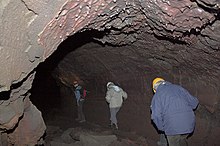Víðgelmir


Víðgelmir (Icelandic pronunciation:
Lava tubes are formed when a low-viscosity lava flow develops a continuous and hard crust which then thickens and forms a roof above the molten lava stream. When the eruption subsides, the still-molten lava moving beneath the crust will continue to drain downhill, leaving an open lava tube.[2] Many other lava tubes have been discovered in Hallmundarhraun, most notably Surtshellir and Stefánshellir.
References
- ^ "Víðgelmir Cave". Archived from the original on 2011-07-04. Retrieved 2007-09-11.
- ^ "Birth of Lava Tubes". Retrieved 2011-07-02.
64°45′01″N 20°48′06″W / 64.750283°N 20.801700°W
